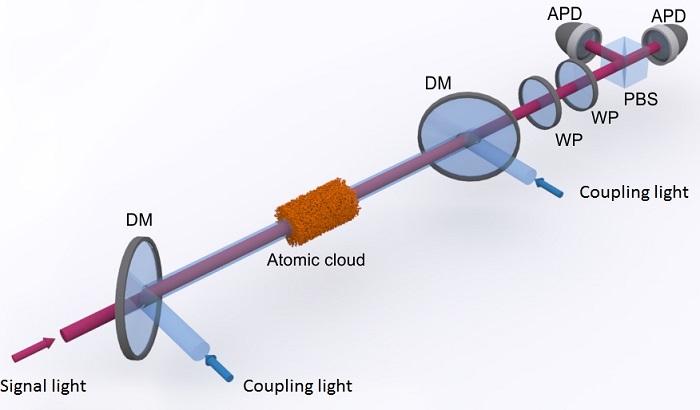May 02, 2016
Scientists from all over the world are working on concepts for future quantum computers and their experimental realization. Commonly, a typical quantum computer is considered to be based on a network of quantum particles that serve for storing, encoding and processing quantum information. In analogy to the case of a classical computer a quantum logic gate that assigns output signals to input signals in a deterministic way would be an essential building block. A team around Dr. Stephan Dürr from the Quantum Dynamics Division of Prof. Gerhard Rempe at the Max Planck Institute of Quantum Optics has now demonstrated in an experiment how an important gate operation – the exchange of the binary bit values 0 and 1 – can be realized with single photons. A first light pulse containing one photon only is stored as an excitation in an ultracold cloud of about 100 000 rubidium atoms. This gives rise to the effect that a second light pulse that passes through the cloud exhibits a phase shift of 180 degrees (Science Advances, 29. April 2016).
“Photons are ideal carriers of quantum information because they hardly interact with their environment and can easily be transmitted over long distances,“ explains Dr. Stephan Dürr, leader of the project. “Therefore we are very interested in the development of a photon-photon-quantum gate where a single light pulse can modify an incoming photonic qubit in a deterministic way.”
Modern data processing is based on the principle that information can be encoded in a binary system. In this context, logic gates fulfil the task of implementing truth tables which uniquely assign a specific output pattern to a given input signal. For instance an input value of 0 can be transformed into an output value of 1 or vice versa. In a photon-photon-quantum gate, this corresponds to the process of a single photon manipulating the state of a second single photon in a deterministic way. This interaction has to be mediated by matter. Up to now no physical system could be found to provide a sufficiently strong interaction.
In this experiment a cloud of about 100 000 rubidium atoms is cooled down to a temperature of 0.5 microkelvin and caught in a dipole trap composed of several light fields. Next, a rapid sequence of three light pulses impinges onto the cloud: the first so-called control pulse determines whether the second target pulse is significantly modified when it passes through the cloud, i.e. whether the gate operation is switched on or off. A third pulse is used to retrieve an excitation that has potentially been stored.
The light pulses consist of two components: on the one hand, they contain red signal light so weak that a light pulse carries only one photon on average. With a wavelength of 780 nm it is near-resonant with a certain atomic transition. Without further treatment the light pulse would pass through the atomic cloud and acquire a certain phase shift. However, by adding blue coupling light of high intensity with a wavelength of 480 nm the photon in the signal pulse can be stored in a controlled and reversible way. During this process, one atom in the cloud is transferred into a highly excited Rydberg state where one electron is located at a large distance from the nucleus.
In the next step, the atoms are irradiated with the target pulse which is also composed of both signal and coupling light. As the Rydberg atom exhibits a long-range van der Waals interaction with the other atoms in the cloud, atomic energy levels inside a certain region around the Rydberg atom are shifted. This results in a larger detuning of the target pulse from the atomic levels compared to the case without a previously stored control pulse.
Because of this detuning the target pulse picks up a phase shift that differs by 180 degrees from the phase shift obtained when no control excitation is stored. “It is this additional phase shift, caused by the van der Waals interaction, that really matters,” says Dr. Dürr. “This makes it possible to generate quantum states that are orthogonal to each other, which corresponds to a bit flip from 0 to 1.” In the last step, a coupling light pulse retrieves the signal photon that is stored in the cloud.
In a series of measurements, using wave plates and a polarizing beam splitter the scientists determined the polarization of both red signal photons after passing through the atomic cloud. Thereby they were able to show that the light pulse had picked up an additional phase shift of 180 degrees whenever the signal laser was switched on during the control pulse. The whole cycle – the storage of the control pulse, the propagation of the target pulse and the retrieval of the control excitation – takes only a few microseconds.
“The experiment demonstrates that we can rotate the polarization plane of the photonic qubit in the target pulse with just one control photon,“ resumes Dr. Dürr. “This is an important prerequisite for the realization of a quantum gate. However, a quantum gate also has to provide the possibility to generate an entangled final state from two separate initial states. To achieve this goal we are planning to do further experiments.” Olivia Meyer-Streng
Original publication
Daniel Tiarks, Steffen Schmidt, Gerhard Rempe, Stephan Dürr
Optical Pi Phase Shift Created with a Single-Photon Pulse
Science Advances, 29. April 2016















